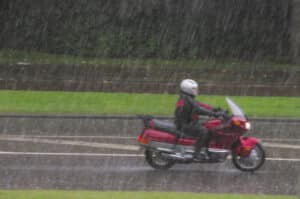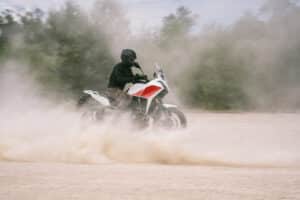How Spring Weather Conditions Affect Motorcycle Safety
Spring brings a return to warmer weather, making it a great time to get your motorcycle back on the road after a long winter hiatus from riding. While the warmer spring temperatures make for more enjoyable riding weather than you’ll experience during the frigid winter months, it’s important to remember that spring weather is extremely variable. Weather conditions can change dramatically at a moment’s notice during spring, often without warning. It’s important to understand how this adverse weather will impact your safety on a spring motorcycle ride.
Common Safety Issues to Be Aware of During Spring Motorcycle Rides
Spring weather conditions can pose several safety hazards for motorcyclists that require extra caution and preparation. Some of the most common issues to be aware of include:
- Wet roads – Spring in Colorado is typically associated with heavy rain. This can make roads slippery and reduce traction for motorcycles. It can also make for soggy riding conditions if you don’t have the appropriate rain gear with you.
- Debris and uneven surfaces – Spring weather can leave roads with debris such as sand, gravel, leaves and potholes that can be dangerous for motorcycles.
- Changing temperatures – Temperatures can fluctuate greatly in spring, requiring riders to have appropriate protective gear to stay warm and avoid hypothermia or overheating.
- Reduced visibility – Rain, fog and glare from the sun can all reduce visibility for motorcyclists.
- Wildlife activity – Increased animal activity in spring, especially deer, can increase the risk of a motorcycle accident.
Safety Tips for Spring Motorcycle Rides in the Rain
 Rain poses a variety of safety hazards for motorcyclists. Wet roads can impact your stopping time and make it more difficult to maneuver your motorcycle. In addition, the glare coming from wet roads can reduce visibility. But the most dangerous condition you’ll encounter on wet roads are slick, oily riding surfaces. The first few minutes of a rainstorm create the most slippery riding conditions. During this time, rainwater will fill in the dimples on the road, causing oil residue to rise to the top. This makes for a very slick surface that can reduce tire traction and increase your risk of a motorcycle accident.
Rain poses a variety of safety hazards for motorcyclists. Wet roads can impact your stopping time and make it more difficult to maneuver your motorcycle. In addition, the glare coming from wet roads can reduce visibility. But the most dangerous condition you’ll encounter on wet roads are slick, oily riding surfaces. The first few minutes of a rainstorm create the most slippery riding conditions. During this time, rainwater will fill in the dimples on the road, causing oil residue to rise to the top. This makes for a very slick surface that can reduce tire traction and increase your risk of a motorcycle accident.
While it’s best to avoid riding in the rain, sometimes it’s simply unavoidable. If you find yourself on a motorcycle ride during a rainstorm, take the following precautions:
- Reduce your speed
- Increase the distance between you and the vehicle in front of you
- Avoid hard braking, quick acceleration and abrupt turns
- Be careful around puddles and standing pools of water since it’s hard to determine how deep the water is or whether the puddle is obscuring a pothole underneath
- If the roads are too slick or slippery to safely maneuver a motorcycle, pull over and wait for the storm to pass
Safety Tips for Spring Motorcycle Rides in the Fog
Foggy conditions are common during spring, especially early in the morning or after a rainstorm. Due to limited visibility in fog, the best approach is to pull over and wait for the fog to pass before continuing your ride. However, if you must ride a motorcycle in the fog, take the following precautions:
- Reduce your speed significantly to give yourself more time to react to hazards and obstacles that might not be easy to identify in poor visibility
- Use low beams and fog lights (high beams will reflect off the fog and reduce visibility)
- Increase your following distance significantly since you’ll need more time to react and brake in the fog
- Avoid changing lanes or passing other vehicles since it’s harder to judge distances and positions in the fog
- Wear bright, reflective clothing to make yourself more visible to other drivers
- Stay focused on the road and your surroundings, and avoid sudden maneuvers
Safety Tips for Spring Motorcycle Rides in the Wind
 Spring weather is often accompanied by strong winds which can make it much harder to maneuver a motorcycle. In situations where winds are very strong, it’s best to avoid riding a motorcycle. This is especially true if the wind is blowing from the side. If you encounter sudden high winds in the middle of a ride, find a safe place to pull over as soon as possible.
Spring weather is often accompanied by strong winds which can make it much harder to maneuver a motorcycle. In situations where winds are very strong, it’s best to avoid riding a motorcycle. This is especially true if the wind is blowing from the side. If you encounter sudden high winds in the middle of a ride, find a safe place to pull over as soon as possible.
If you have to ride your motorcycle during high winds, take the following precautions:
- Reduce your speed
- Increase the following distance between yourself and the vehicle in front of you
- Grip the handlebars firmly to maintain control
- Stay in the middle of the lane so you have room to move to the left or right if your motorcycle is being blown around by the wind
- When you encounter crosswinds, counter steer slightly to compensate for the winds pushing on your motorcycle
Safety Tips for Spring Motorcycle Rides in the Hail
Spring is hail season in Colorado. It’s common for hail stones to be large, placing you at risk of significant injury due to the lack of protection provided by a motorcycle. Due to significant obstruction in vision, high risk of injury and the potential to damage your motorcycle, you should avoid riding in hail. If you’re caught in a hailstorm while riding, you should seek immediate shelter. Find a safe place to pull over that will shield you from the hail, such as under a bridge or in a building.
Keep in mind that hail is often accompanied by thunderstorms and lightning, which poses a serious threat to motorcyclists. If you see lightning or hear thunder, pull over and seek shelter immediately, as it is never safe to ride in these conditions.
Make Sure to Have the Right Gear
Spring weather is variable and can change quickly. Therefore, it’s important to always ride with the proper gear for any potential weather condition that may arise:
- Always ride in your motorcycle jacket, pants and boots
- Keep waterproof rain gear on hand in the event that you encounter a storm while riding
- If your ride is going to extend into the evening hours, bring cold weather gear so that you can stay warm when the temperature drops significantly at sunset
Pushchak Law Can Help After a Motorcycle Accident
Even when you take all the precautions discussed above, there’s always a risk of getting into an accident when riding in adverse spring weather conditions. If you’re injured in a motorcycle accident caused by the negligence of another driver, you may be entitled to compensation for your damages. At Pushchak Law, we’ll fight aggressively to protect your rights and help you recover the compensation you deserve.
Brian Pushchak has made motorcycle accident cases a primary focus of his practice. He understands the complex laws governing these cases and the unique issues impacting motorcycle riders. This specialization will give you the edge you need when seeking to maximize the value of your compensation.
You’ll also benefit from Mr. Pushchak’s unique Informed Decisions™ Approach focused on helping you achieve the best possible outcome to your case. This approach to motorcycle accident cases keeps you in control of the process at all times.
Mr. Pushchak will talk to you at length about your goals for the case, and he’ll explain your legal rights and options in detail. You’ll have an opportunity to ask any questions you may have to ensure you understand Mr. Pushchak’s recommended strategy for your case. This will arm you with the information necessary to make the right decision regarding the strategy used to pursue your compensation.
Contact us today to schedule a free consultation. Pushchak Law serves clients in Denver and the surrounding areas of Colorado.
- Does Motorcycle Insurance Cover Medical Bills After an Accident? - August 30, 2024
- How to Recognize Signs of Fear in Dogs - August 16, 2024
- How to Safely Navigate Heavy Traffic on a Motorcycle - August 9, 2024
Free Case Consultation
If you have been injured and would like to speak with one of our attorneys, take advantage of our free, no-obligation consultation. And if you have a viable case, there are no fees until we win.
Call 303.372.6145


